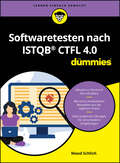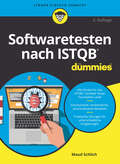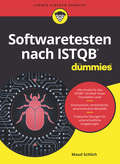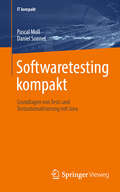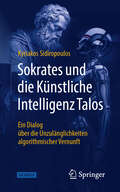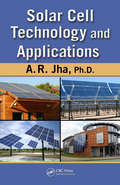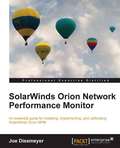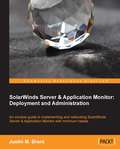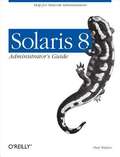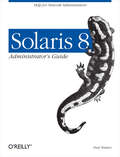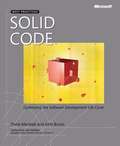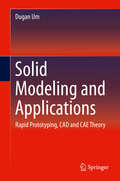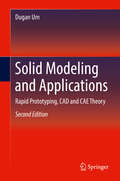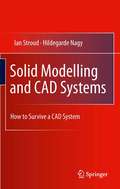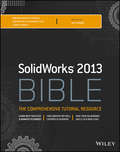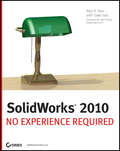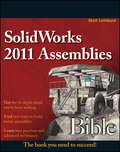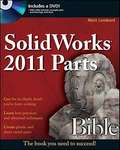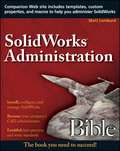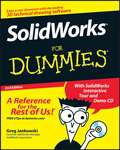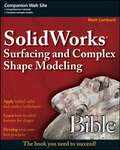- Table View
- List View
Softwaretesten nach ISTQB CTFL 4.0 für Dummies (Für Dummies)
by Maud SchlichNeue Hauptversion 4.0: Neuer Lehrplan, geänderter Prüfungsumfang! Soll in Ihrem Unternehmen neue Software eingeführt werden und Sie müssen sie testen? Oder wollen Sie als Entwickler über den Tellerrand schauen und sich auch mit dem Softwaretesten beschäftigen? Leicht verständlich erläutert Ihnen Maud Schlich alle vom ISTQB® Certified Tester Foundation Level geforderten Lerninhalte sowohl für Programmierer als auch mit Blick auf Fachanwender, die die Software später einsetzen. Zahlreiche praxisorientierte Beispiele und übungen sorgen für eine optimale Prüfungsvorbereitung. Darüber hinaus erfahren Sie für alle Testaktivitäten, wie sie jeweils im klassischen oder im agilen Kontext geplant und durchgeführt werden. Sie erfahren Aus welchen Aktivitäten der Testprozess besteht Wie Sie unterschiedliche Testverfahren nutzen Wie Entwickler und Tester optimal zusammenarbeiten Wie Sie prüfen, ob Sie noch im Plan sind
Softwaretesten nach ISTQB für Dummies (Für Dummies)
by Maud SchlichSoll in Ihrem Unternehmen neue Software eingeführt werden und Sie müssen sie testen? Und Sie wissen nicht, wie Sie das angehen sollen? Oder wollen Sie als Entwickler über den Tellerrand schauen und sich auch mit dem Softwaretesten beschäftigen? Dieses Buch erläutert alle vom ISTQB® Certified Tester Foundation Level geforderten Lerninhalte sowohl für den Anwender mit Fachkenntnissen, der Software später einsetzen wird, als auch für den Programmierer. Die à bungen sind leicht in die eigene Praxis übertragbar und sorgen für eine optimale Prüfungsvorbereitung. Darüber hinaus wird für alle Testaktivitäten gezeigt, wie diese jeweils im klassischen oder im agilen Kontext aussehen.
Softwaretesten nach ISTQB für Dummies (Für Dummies)
by Maud SchlichSoll in Ihrem Unternehmen neue Software eingeführt werden und Sie sollen sie testen? Und Sie wissen nicht, wie Sie das angehen sollen? Oder wollen Sie als Entwickler über den Tellerrand schauen und sich auch mit dem Softwaretesten beschäftigen? Dieses Buch erläutert alle vom ISTQB® Certified Tester Foundation Level geforderten Lerninhalte sowohl für den Anwender mit Fachkenntnissen, der Software später einsetzen wird, als auch für den Programmierer. Die Übungen sind leicht in die eigene Praxis übertragbar und sorgen für eine optimale Prüfungsvorbereitung. Darüber hinaus wird für alle Testaktivitäten gezeigt, wie diese jeweils im klassischen oder im agilen Kontext aussehen.
Softwaretesting kompakt: Grundlagen von Tests und Testautomatisierung mit Java (IT kompakt)
by Daniel Sonnet Pascal MollSoftwaretests sind unverzichtbar für jede robuste Software. Dies zeigt sich durch nahezu wöchentliche Bugbedingte Ausfälle. Doch wie lassen sich diese effektiver verhindern? Nach dem Lesen dieses Buches sind Sie in der Lage, eigene Softwaretests in den unterschiedlichsten Industriebereichen mit Java umzusetzen. Dieses Buch richtet sich an alle, die in die Disziplin des Testens eintauchen möchten. Es nimmt Sie direkt an die Hand und führt Sie Schritt für Schritt durch die unterschiedlichen Bereiche, es sind keine Vorkenntnisse im Testing oder Programmierung notwendig. Lernen Sie essenzielle Testtheorie kennen und wie Sie in der Praxis verschiedene Testarten einsetzen. Die notwendigen Java-Grundkenntnisse zur Testimplementierung werden Ihnen anhand von Beispielen immer aus der Sicht eines Testers praxisnah vermittelt. Erfahren Sie mehr über Testautomatisierung mit JUnit, Oberflächentests mit Selenium und Mocking von APIs mit WireMock. Lernen Sie die Anwendung von Behaviour Driven Development mit Cucumber kennen sowie exploratives Testen.
Soil-Water, Agriculture, and Climate Change: Exploring Linkages (Water Science and Technology Library #113)
by Pankaj Kumar Gupta Swatantra Kumar Dubey Prakash Kumar Jha Aliva Nanda Vivek GuptaThis book presents an exploration of linkages among soil-water, agriculture, and climate change with a special focus on thematic areas for assessment, mitigation, and management of natural resources under climate change conditions. This book covers advances in modelling approaches, including machine learning (ML)/ artificial intelligence (AI) applications; GIS and remote sensing; sensors; impacts of climate change on agriculture; subsurface water; contaminants; and socio-economic impacts, which are lacking in a more comprehensive manner in the previous titles. This book encompasses updated information as well as future directions for researchers working in the field of management of natural resources. The goal of this book is to provide scientific evidence to researchers and policymakers and end-to-end value chain practitioners which may help in reducing the overall adverse impacts of climate change on water resources and the related mitigation strategies. This book focuses on the knowledge, modern tools, and techniques, i.e., machine learning, artificial intelligence, etc. for soil-water, agriculture, and climate change. Further, nature-based solutions for management of natural resources with special targets on contaminants, extreme events, disturbances, etc. will be targeted. The book provides readers with the enhanced knowledge for application of engineering principles and economic and regulatory constraints to determine a soil-water, agriculture production action strategy, and select appropriate technologies to implement the strategy for a given data set at a site. It would also cover the application of laboratory, modeling, numerical methods for determination and forecasting of climate change impacts, agriculture production, pollution, soil health, etc. Overall, it provides hydrologists, environmental engineers, administrators, policy makers, consultants, and industrial experts with essential support in effective management of soils health, agricultural productions, and mitigation of extreme climatic events.
Sokrates und die Künstliche Intelligenz Talos: Ein Dialog über die Unzulänglichkeiten algorithmischer Vernunft
by Kyriakos SidiropoulosDas Sachbuch stellt die Debatte über künstliche Intelligenz in einen philosophischen Rahmen und nutzt dabei den Dialog als narrative Form. Im heutigen Athen stellen Sokrates und seine Schüler Platon und Aristoteles einem fiktiven KI-System namens Talos eine Reihe von Fragen, die die Grenzen des menschlichen und maschinellen Denkens ausloten. Der Dialog lädt zur Reflexion über grundlegende Themen wie die Natur des Wissens, des Bewusstseins, der Ethik und der menschlichen und maschinellen Autonomie ein. Das Buch bietet nicht nur Einblicke in die Chancen und Herausforderungen intelligenter Maschinen, sondern regt auch zur kritischen Diskussion über die ethischen und praktischen Konsequenzen ihrer Entwicklung an. Ein inspirierender Beitrag für alle, die philosophische und gesellschaftliche Fragen der künstlichen Intelligenz besser verstehen und mitdiskutieren möchten.
Solar Cell Technology and Applications
by A. R. JhaEnergy experts predict that wholesale electricity prices could easily rise 35 to 65 percent by 2015. Add to this the growing need for energy independence and the need to reduce carbon emissions and it is very clear that the development of low-cost renewable energy, such as solar energy, is essential for our economy and our national security. With t
Solar PV and Wind Energy Conversion Systems
by S. Sumathi L. Ashok Kumar P. SurekhaThis textbook starts with a review of the principles of operation, modeling and control of common solar energy and wind-power generation systems before moving on to discuss grid compatibility, power quality issues and hybrid models of Solar PV and Wind Energy Conversion Systems (WECS). MATLAB/SIMULINK models of fuel cell technology and associated converters are discussed in detail. The impact of soft computing techniques such as neural networks, fuzzy logic and genetic algorithms in the context of solar and wind energy is explained with practical implementation using MATLAB/SIMULINK models. This book is intended for final year undergraduate, post-graduate and research students interested in understanding the modeling and control of Solar PV and Wind Energy Conversion Systems based on MATLAB/SIMULINK. - Each chapter includes "Learning Objectives" at the start, a "Summary" at the end and helpful Review Questions - Includes MATLAB/SIMULINK models of different control strategies for power conditioning units in the context of Solar PV - Presents soft computing techniques for Solar PV and WECS, as well as MATLAB/SIMULINK models, e. g. for wind turbine topologies and grid integration - Covers hybrid solar PV and Wind Energy Conversion Systems with converters and MATLAB/SIMULINK models - Reviews harmonic reduction in Solar PV and Wind Energy Conversion Systems in connection with power quality issues - Covers fuel cells and converters with implementation using MATLAB/SIMULINK
SolarWinds Orion Network Performance Monitor
by Joe DissmeyerThis book is written in a friendly manner written by an expert with numerous years of practical experience utilizing SolarWinds Orion NPM as a network monitoring solution.This book is for systems administrators, system analysts, and systems engineers who are tasked with installing and implementing a network performance monitor. Knowledge of basic network concepts is required.
SolarWinds Server & Application Monitor: Deployment and Administration
by Justin M. BrantA concise and practical guide to using SolarWinds Server & Application Monitor.If you are an IT professionals ranging from an entry-level technician to a more advanced network or system administrator who is new to network monitoring services and/or SolarWinds SAM, this book is ideal for you.
Solaris 8 Administrator's Guide
by Paul WattersThis guide covers all aspects of deploying Solaris as an enterprise-level network operating system, with a focus on e-commerce. Written for experienced network administrators who want an objective guide to networking with Solaris, the book covers installation on the Intel and Sparc platforms, and instructs you how to setup Solaris as a file server, application server, and database server.
Solaris 8 Administrator's Guide: Help for Network Administrators
by Dr Paul Andrew WattersThe Solaris operating system, along with related Sun products likeJava, is one of the most reliable and scalable platforms on whichto build e-commerce products, and on which to support all networkedservices. Yet, one problem that potential users face is finding outmore information about what Solaris offers. In a sense, they want toknow how much technical work is involved in migrating to Solaris,and what kind of philosophy Solaris is based on.To answer these questions, Solaris 8 Administrator's Guidecovers all aspects of deploying Solaris as a network server, includingboth basic and advanced network services. Given newfound interest inSolaris as an enterprise network operating system, this guide is aimedsquarely at supporting enterprise-level services. It's written forexperienced network administrators who want an objective guide tonetworking with Solaris, and covers installation on both the Inteland Sparc platforms. With it, you will learn how to setup Solaris asa file server, application server, and database server.In its coverage of advanced topics, Solaris 8 Administrator's Guideoffers examples of configuration files and the installation of third-partysoftware packages. This comprehensive book also contains more conceptualand difficult material that is absent from other Solaris reference manuals.At all points, emphasis is placed on issues like evaluating the security,scalability, and reliability of specific software packages--at the expenseof providing detailed coverage of every available package.The book covers the practical experience and new skills needed to understandthe impact of new services and new software products on existing server systems.Author Paul Watters--a recognized authority on Solaris--avoids so-called"historical" services, like UUCP, which can easily fill chapters but arenot commonly found in today's production environments. Indeed, he doesn'tbother to provide an in-depth history of Solaris or UNIX at all, assumingthat you can find this material elsewhere. Instead, the practical focus ison supporting relevant contemporary networking technologies.Solaris 8 Administrator's Guide provides you with a third-party viewthat not only praises Solaris, but is critical and realistic in its assessment.This book is for experienced Solaris Administrators as well as and those lookingto migrate to this operating system.
Sold to the Man With the Tin Leg
by Philip SerrellWhen Philip Serrell - now well known for his television appearances - gave up teaching to become a professional auctioneer, he thought he was embarking on a sensible and safe career . . . a quiet life in the country with no surprises. In THE AUCTIONEER'S LOT we found out how wrong he was. SOLD TO THE MAN WITH THE TIN LEG Philip describes more of his extraordinary experiences as a country auctioneer, aided and abetted by some of the most colourful characters Worcestershire has to offer. From dodgy cars to fakes in the saleroom; angry livestock, mangled silverware and tortuous - not to mention muddy - experiences in local markets and farm sales, Philip has been there, done that and got the hoofprints on his suit to prove it. And of course, there's the return¬? Philip's tin-legged boss . . .
Sold to the Man With the Tin Leg
by Philip SerrellWhen Philip Serrell - now well known for his television appearances - gave up teaching to become a professional auctioneer, he thought he was embarking on a sensible and safe career . . . a quiet life in the country with no surprises. In THE AUCTIONEER'S LOT we found out how wrong he was. SOLD TO THE MAN WITH THE TIN LEG Philip describes more of his extraordinary experiences as a country auctioneer, aided and abetted by some of the most colourful characters Worcestershire has to offer. From dodgy cars to fakes in the saleroom; angry livestock, mangled silverware and tortuous - not to mention muddy - experiences in local markets and farm sales, Philip has been there, done that and got the hoofprints on his suit to prove it. And of course, there's the return  Philip's tin-legged boss . . .
Solid Code
by Donis Marshall John BrunoGet best-in-class engineering practices to help you write more-robust, bug-free code. Two Microsoft .NET development experts share real-world examples and proven methods for optimizing the software development life cycle--from avoiding costly programming pitfalls to making your development team more efficient. Managed code developers at all levels will find design, prototyping, implementation, debugging, and testing tips to boost the quality of their code--today. Optimize each stage of the development process--from design to testing--and produce higher-quality applications. Use metaprogramming to reduce code complexity, while increasing flexibility and maintainability Treat performance as a feature--and manage it throughout the development life cycle Apply best practices for application scalability Employ preventative security measures to ward off malicious attacks Practice defensive programming to catch bugs before run time Incorporate automated builds, code analysis, and testing into the daily engineering process Implement better source-control management and check-in procedures Establish a quality-driven, milestone-based project rhythm--and improve your results!
Solid Modeling and Applications
by Dugan UmThe lessons in this fundamental text equip students with the theory of Computer Assisted Design (CAD), Computer Assisted Engineering (CAE), the essentials of Rapid Prototyping, as well as practical skills needed to apply this understanding in real world design and manufacturing settings. The book includes three main areas: CAD, CAE, and Rapid Prototyping, each enriched with numerous examples and exercises. In the CAD section, Professor Um outlines the basic concept of geometric modeling, Hermite and Bezier Spline curves theory, and 3-dimensional surface theories as well as rendering theory. The CAE section explores mesh generation theory, matrix notion for FEM, the stiffness method, and truss Equations. And in Rapid Prototyping, the author illustrates stereo lithographic theory and introduces popular modern RP technologies. Solid Modeling and Applications: Rapid Prototyping, CAD and CAE Theory is ideal for university students in various engineering disciplines as well as design engineers involved in product design, analysis, and validation.
Solid Modeling and Applications: Rapid Prototyping, Cad And Cae Theory
by Dugan UmThis updated, second edition provides readers with an expanded treatment of the FEM as well as new information on recent trends in rapid prototyping technology. The new edition features more descriptions, exercises, and questions within each chapter. In addition, more in-depth surface theory has been introduced in section four, with particular emphasis in surface theory. Promising cutting edge technologies in the area of rapid prototyping are introduced in section seven, MATLAB-based FEM analysis has been added in section eight, and development of the plan stress and plane strain stiffness equations are introduced as a new chapter. Revised and updated based on student feedback, Solid Modeling and Applications: Rapid Prototyping, CAD and CAE Theory is ideal for university students in various engineering disciplines as well as design engineers involved in product design, analysis, and validation. It equips them with an understanding of the theory and essentials and also with practical skills needed to apply this understanding in real world design and manufacturing settings.
Solid Modelling and CAD Systems
by Hildegarde Nagy Ian StroudSolid Modelling and CAD Systems gives users an insight into the methods and problems associated with CAD systems. It acts as a bridge between users who learn interfaces without understanding how they work and developers who create systems without understanding the needs of the users. The main feature of Solid Modelling and CAD Systems is a logical analysis of the techniques and basic solid modelling methods used in modern CAD systems. The book goes on to describe, among other subjects: two-dimensional shape definition methods,the command interface and graphics,databases and data exchange,early-phase design, andcommand files and command structures. Reading Solid Modelling and CAD Systems will help users understand the limitations of the techniques they are using and will enable practitioners to use CAD systems more efficiently. It is a valuable tool for designers, as well as for advanced undergraduate and postgraduate students. The exercises it contains allow readers to try out different aspects of the subject matter and the book also includes projects that can be used for teaching purposes.
SolidWorks 2009 Bible
by Matt LombardSolidWorks Bible is a comprehensive reference-tutorial that covers the basics, but then quickly ramps up to more advanced level topics. Every feature is thoroughly covered yet written in a way that makes learning this robust program seem non-threatening and uncomplicated. In a market full of books for beginners this is the one book that goes into extensive detail, not just on "how" the software works, but in many cases "why" it works the way it does. The author is well known in the SolidWorks community and uses SolidWorks on a daily basis as his main design tool in his contracting and consulting work. Many topics covered in SolidWorks Bible are not found in any other publication or even documentation directly from SolidWorks.Note: CD-ROM/DVD and other supplementary materials are not included as part of eBook file.
SolidWorks 2010: No Experience Required
by Alex Ruiz Gabi JackThe only continuous, step-by-step tutorial for SolidWorks SolidWorks is a 3D CAD manufacturing software package that has been used to design everything from aerospace robotics to bicycles. This book teaches beginners to use SolidWorks through a step-by-step tutorial, letting you build, document, and present a project while you learn. Tools and functionality are explained in the context of professional, real-world tasks and workflows. You will learn the essential functions and gain the skills to use the software at once. SolidWorks is a popular design software for manufacturing, and this book introduces it in the context of actually creating an object Begins with an overview of SolidWorks conventions and the interface Explains how to create models and drawings, create a revolved part and subassembly, and model parts within a subassembly Explores modification capabilities and drawing and Bill of Materials templates Moves on to top-level assembly models and drawings, Toolbox components and the Design Library, mates, export and printing capabilities, and creating renderings Includes a glossary, a foreword from the SolidWorks product manager, and downloadable tutorial files SolidWorks 2010: No Experience Required quickly turns beginners into confident users of SolidWorks.
SolidWorks 2011 Assemblies Bible
by Matt LombardA fan of the SolidWorks Bible, but want more detail on assemblies? Here you go. SolidWorks fans have long sought more detail on SolidWorks topics, and now you have it. We took our popular SolidWorks Bible, divided it into two books (SolidWorks 2011 Assemblies Bible and SolidWorks 2011 Parts Bible) and packed each new book with a host of items from your wish lists, such as more extensive coverage of the basics, additional tutorials, and expanded coverage of topics largely ignored by other books. This SolidWorks 2011 Assemblies Bible shows you how to organize parts data to create assemblies or subassemblies using the latest version of the 3D solid modeling program, SolidWorks Thoroughly describes best practices and beginning-to-advanced techniques using both video and text Explains and thoroughly covers every assembly function and is written in a way that enables the reader to make better decisions while using the software Written by well-known and well-respected SolidWorks guru Matt Lombard Can stand alone or also with the SolidWorks 2011 Parts Bible for a complete SolidWorks reference set Keep both the SolidWorks 2011 Assemblies Bible and the SolidWorks 2011 Parts Bible on your desk, and you?ll have the best resource set out there on SolidWorks.
SolidWorks 2011 Parts Bible
by Matt LombardLike the SolidWorks Bible, but want more on parts? New version provides greater detail than everSolidWorks fans have long sought more detail and information on SolidWorks topics, and now you have it. We took our popular SolidWorks Bible, divided it into two books (SolidWorks 2011 Parts Bible and SolidWorks 2011 Assemblies Bible) and packed each new book with a host of items from your wish lists, such as more extensive coverage of the basics, additional tutorials, and expanded coverage of topics largely ignored by other books.This SolidWorks Parts Bible shows you how to do parts modeling and parts drawing using the latest version of the 3D solid modeling program, SolidWorksThoroughly describes best practices and beginning-to-advanced techniques using both video and textExpands coverage of topics that readers have asked for, including Pack-and-Go, search criteria, and greater coverage of file managementWritten by well-known and well-respected SolidWorks guru, Matt LombardCan stand alone, or also with the SolidWorks 2011 Assemblies Bible, for a complete SolidWorks reference setKeep both the SolidWorks 2011 Parts Bible and the SolidWorks 2011 Assemblies Bible on your desk, and you'll have the best resource set out there on SolidWorks!
SolidWorks Administration Bible
by Matt LombardWhat you need to prepare, install, and maintain SolidWorksIt's not enough to know how to use SolidWorks, if your job also requires you to install or maintain it, train new users, and implement standards. This in-depth guide was written for those of you who have to actually manage your company's SolidWorks system. From hardware selection to helping users to licensing and more, this is the everyday, bread-and-butter SolidWorks administration resource that IT and CAD managers have been seeking.SolidWorks is a powerful 3D solid modeling system that is popular with CAD users everywhere, but often leaves IT administrators in the dark as to how to manage it; this essential guide covers SolidWorks admin for both IT staff and CAD usersWalks you through preparing, installing, and maintaining SolidWorksCovers setting up shared libraries, automated deployment tools, licensing, updates and upgrades, support and troubleshooting, standardization, and collaborationGet the high-level assistance you need to efficiently manage SolidWorks in your enterprise or small business.Note: CD-ROM/DVD and other supplementary materials are not included as part of eBook file.
SolidWorks For Dummies
by Richard Doyle Greg JankowskiWhether it's your first venture into 3D technical drawing software or you're switching to SolidWorks from something else, you're probably excited about what this CAD program has to offer. Chances are, you figure it's going to take awhile to get the hang of it before you can begin cranking out those perfectly precise 3D designs. SolidWorks For Dummies, 2nd Edition, can help you dramatically shorten that get-acquainted period!SolidWorks For Dummies, 2nd Edition will help you get up and running quickly on the leading 3D technical drawing software. You'll see how to set up SolidWorks to create the type of drawings your industry requires and how to take full advantage of its legendary 3D features. You'll discover how to:Work with virtual prototypesUnderstand the user interfaceUse templates and sketch, assemble, and create drawingsAutomate the drawing processReview drawings and collaborate with other team membersDefine and edit sketchesCreate dimensions and annotationsPrint or plot your drawingsLeverage existing designsSample files on the bonus CD-ROM show you how to apply the latest version of SolidWorks and accomplish specific tasks. Even if you're brand-new to CAD software, SolidWorks For Dummies, 2nd Edition will have you feeling like a pro in no time. You'll find you've entered a whole new dimension.Note: CD-ROM/DVD and other supplementary materials are not included as part of eBook file.
SolidWorks Surfacing and Complex Shape Modeling Bible
by Matt LombardIf you want to gain proficiency and expertise with SolidWorks surface modeling, this is the resource for you. You'll learn how to apply concepts, utilize tools, and combine techniques and strategies in hands-on tutorials. This Bible covers the range from sketching splines and shelling to modeling blends and decorative features. Complete with professional tips and real-world examples, this inclusive guide enables you to coax more out of SolidWorks surfacing tools.
